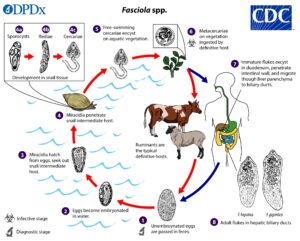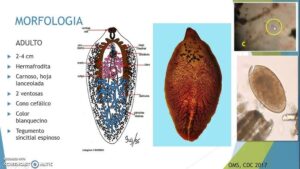Back to: ZOOLOGY 200 Level
It’s wonderful to see you back, ready to learn and grow! Today’s topic will take us into the world of Parasitic Adaptations, using examples like Fasciola and Taenia. Parasites have some of the most fascinating and strategic survival tactics in the animal kingdom. Let’s find out how they manage to live and thrive inside other organisms!
Parasitic adaptations (e.g., Fasciola, Taenia)
What are parasitic adaptations?
Parasitic adaptations are special features or changes in structure, behaviour, or life cycle that allow an organism to live in or on a host, feeding off the host’s body while often causing harm. These adaptations help the parasite survive, reproduce, and avoid being destroyed by the host’s immune system or environment.

Parasites are incredibly skilled at doing just enough damage to get what they need, without killing the host too quickly—because they rely on the host to survive. Let’s now look at some examples.
Adaptations in Fasciola (liver fluke)
Fasciola is a flatworm that infects the liver of animals like sheep, cattle, and even humans. It has a leaf-shaped body that helps it to stay lodged in the liver tissues of its host.
One key adaptation is its strong oral and ventral suckers, which allow it to attach firmly to the liver walls and feed on blood and body fluids. It also has a protective outer covering called the tegument, which shields it from the host’s digestive enzymes and immune responses.
Fasciola produces a very large number of eggs to increase the chance of reaching the next host in its complex life cycle. Its life cycle involves multiple hosts, including freshwater snails and grazing animals, making it well-equipped to survive in varied environments.
Adaptations in Taenia (tapeworm)
Taenia, the tapeworm, lives in the intestines of humans and pigs. It has no digestive system—this might seem like a weakness, but it’s actually a smart adaptation. Instead of using energy to digest food, it simply absorbs nutrients directly through its body surface from the host’s already digested food.
The head, or scolex, has hooks and suckers that help it attach tightly to the host’s intestinal wall. It has a long, ribbon-like body made of proglottids, each of which contains both male and female reproductive organs. This allows it to self-fertilise and produce thousands of eggs regularly, ensuring its life cycle continues.
The eggs have thick shells to withstand harsh environmental conditions until they are ingested by the next host.
Other common parasitic adaptations

- Reduced sense organs, since finding food or moving isn’t necessary inside a host.
- Flat or thin bodies to help squeeze into tissues or cling to surfaces.
- Complex life cycles involving more than one host, which increases survival chances.
These adaptations make parasites very successful at what they do, although they often cause diseases in humans, animals, and crops.
Summary
Parasitic adaptations are features that help parasites survive, reproduce, and avoid being destroyed within their hosts. Fasciola uses suckers, a protective covering, and a multi-host life cycle, while Taenia uses hooks, nutrient absorption, and reproductive strategies. These adaptations allow them to live effectively inside host organisms.
Evaluation
- What are parasitic adaptations?
- List two structural adaptations of Fasciola.
- How does Taenia absorb nutrients?
- Why do parasites produce so many eggs?
Parasites may be small, but their survival skills are mighty. Your growing understanding of Zoology is impressive. Keep shining, and let’s move on to the next exciting lesson—Afrilearn is here with you every step of the way!
